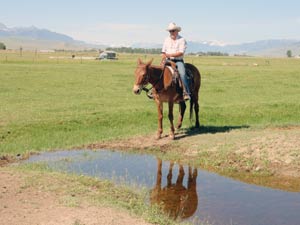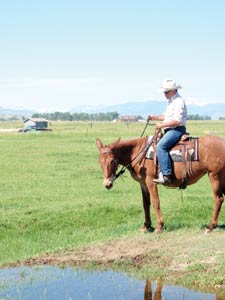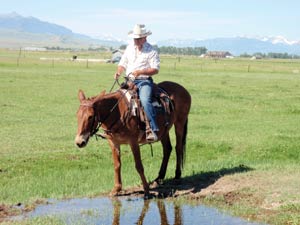|
Water crossings can
turn a wonderful trail ride into a nightmare. You and your
riding friends come out of the timber and see a water crossing.
Your mule spots the water and raises his head. As you get closer
you feel him tighten his muscles in his body.
What do you do now? Stay on? Get off?
You ride him to the edge of the water, and then he stops. When
you cue him to move forward he does not move, instead he backs
up and tries to turn around.
One of your friends has a solution, he will pony your mule
across the water. He grabs the lead rope and starts across. Your
mule stops at the waters edge and locks up his feet, pulling
your friend off the back of his mule.
Another friend has a better idea. He rides in to the back of the
mule and takes his lead rope and starts hitting the mule from
behind. Your mule locks his feet until he has had enough of the
hitting. He kicks out at the other mule.
Now, everyone is getting frustrated and losing their temper. We
must get this mule across the water NOW. As this unfolds, a
bigger and bigger wreck is being created. If you put pressure on
a mule he will resist. The more pressure you put on your mule in
this situation, the more resistance the mule will have.
When you find yourself in this situation, the most important
thing to remember is, it is not the end of the world if the mule
does not cross the water today. By thinking this way, you can
step back, examine the situation, and come up with a training
lesson that will help your mule feel comfortable with crossing
the water.
First, look at the crossing. A mule will not hurt himself so
make sure it is a safe place to cross. If it is not a safe place
to cross, you will be fighting your mule’s instinct as well as
the water. If you see that the crossing is safe, teach the mule
to cross the water. Forcing him will get you nowhere.
Pick a spot on the bank of the water crossing, no larger than
one foot wide. This is where you will cross the water with your
mule. Keep the mule’s nose pointed at the spot no matter which
way his body is positioned. This spot will help keep your mule
focused and help you direct him more effectively.
 |
|
The mule will walk up to the water
and stop. This is your starting point.\
|
Ask the mule to walk
up to the spot. The mule will walk up to the water and stop
where he is comfortable – that is OK. If he stops three feet
from the water, let him stop. This is your starting point to
teach the mule to cross water.
After your mule is relaxed at your “Starting Point,” use the “Go
Forward Cue” from the saddle. Squeeze both legs applying
pressure to the sides of your mule - and ask your mule to take
one step forward. If the mule does not respond, lightly bump the
sides of your mule with your legs. Start lightly and increase
the pressure of the bumps until your mule takes one step
forward.
Remember the mule will learn from the release, so do not stop
bumping until your mule takes a step forward. If your mule moves
any other direction but forward, keep bumping. So if the mule
takes five steps backward, keep bumping until he takes one step
forward.
 |
|
Keep the mule’s nose pointed at the
spot on the bank, no matter which way his body is
positioned. |
When the mule takes a
step forward, stop bumping and praise your mule. Now, let your
mule stand until you believe he is calm. Do not ask him to take
another step forward until you are sure he will try. Be sure you
are still keeping your mule’s head pointed at your spot. Ask
your mule, one step at a time, to move closer to the water’s
edge.
Once at the water,
your mule may want to put his head down to smell the water, he
may paw or look at the water. Let him do this. For any equine,
this is their way of making sure it is safe for them to cross.
At this point, your mule is thinking forward. You are teaching
the mule to cross the water, just as you taught your mule to
load into a trailer.
Have the mule step
into the water with one foot, then two feet, and so on. Your
mule may back up a few times when he feels the water on his
feet. If so, just ask him to take a step forward again. Be
patient. Give your mule plenty of time between requests.
 |
|
Have the mule step into the water
with one foot, then two feet, and so on. |
Remember, you do not
have to teach the mule the complete lesson at one time. Anytime
you ask the mule to respond to a cue and your mule responds
calmly and correctly, you can stop and continue the lessons
later.
The first time your mule crosses the water, he may cross quickly
or try to jump part of it. In this case, ask him to cross again
until your mule crosses calmly. By going slowly and keeping your
mule clam, you will actually get your mule to cross the water
quicker.
But remember, if he will not cross the water today, it is not
the end of the world. With practice and patience you will have a
mule that will not only cross water, but any obstacle you ask
him to cross.
|